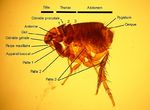Difference between revisions of "Ctenocephalides felis"
| (18 intermediate revisions by 3 users not shown) | |||
| Line 1: | Line 1: | ||
| − | {{ | + | {{OpenPagesTop}} |
| + | {{Taxobox | ||
| + | |name = ''Ctenocephalides felis | ||
| + | |kingdom = | ||
| + | |phylum = | ||
| + | |class = [[:Category:Insecta|Insecta]] | ||
| + | |sub-class = | ||
| + | |order = [[Siphonaptera]] | ||
| + | |super-family = | ||
| + | |family = Pulicidae | ||
| + | |sub-family = | ||
| + | |genus = | ||
| + | |species = ''Ctenocephalides felis | ||
| + | }} | ||
| + | [[Image:Cat flea.jpg|thumb|right|150px|Cat Flea - August La Roux 2007, Wikimedia Commons]] | ||
| − | + | Also known as: '''''Cat flea | |
| − | + | ''Ctenocephalides felis'' is the most commonly seen flea on both cats and dogs, and is of the order [[Siphonaptera]]. It is also an important intermediate host in the parasite [[Dipylidium caninum|''Dipylidium caninum'']]. | |
| − | |||
| − | |||
| − | |||
| − | |||
| − | |||
| − | ''Ctenocephalides felis'' is the most commonly seen flea on both cats and dogs, | ||
| − | |||
| − | |||
| − | |||
| − | |||
| − | |||
| − | |||
| − | |||
| − | |||
| − | |||
| − | |||
| − | |||
| − | |||
| − | |||
==Hosts== | ==Hosts== | ||
| Line 28: | Line 23: | ||
==Identification== | ==Identification== | ||
| − | The adults | + | The adults are dark-brown, and have fascicles and laciniae adapted for piercing skin and sucking blood. They have large legs, containing resilin, adapted for jumping, and are laterally flattened, so they can easily move through the hair of the hosts. The adults have rows of spines, known as 'combs' or 'ctenidia', which are very important in the identification process. The first genal spine is 0.75 times the length of the second |
| + | |||
| + | See [[Flea Structure|general flea structure]]. | ||
==Life Cycle== | ==Life Cycle== | ||
| Line 35: | Line 32: | ||
When the parasite is fully developed the adults emerge from the pupae, but remain within the cocoon. They will hatch out of the pupae when stimulated by movement, or heat. Overall, most of the life cycle is spent away from the host. | When the parasite is fully developed the adults emerge from the pupae, but remain within the cocoon. They will hatch out of the pupae when stimulated by movement, or heat. Overall, most of the life cycle is spent away from the host. | ||
| − | [[Category:Cat]][[Category:Dog]] | + | See [[Flea Life Cycle|general flea life cycle]]. |
| + | |||
| + | {{Learning | ||
| + | |flashcards = [[Fleas_Flashcards|Fleas Flashcards]] | ||
| + | |literature search = [http://www.cabdirect.org/search.html?rowId=1&options1=AND&q1=title%3A%28%22Ctenocephalides+felis%22%29+&occuring1=freetext&rowId=2&options2=AND&q2=&occuring2=freetext&rowId=3&options3=AND&q3=&occuring3=freetext&publishedstart=2000&publishedend=yyyy&calendarInput=yyyy-mm-dd&la=any&it=any&show=all&x=51&y=11 ''Ctenocephalides felis'' publications since 2000] | ||
| + | |Vetstream = [https://www.vetstream.com/canis/search?s=flea Fleas] | ||
| + | }} | ||
| + | |||
| + | |||
| + | {{OpenPages}} | ||
| + | |||
| + | [[Category:Cat Parasites]][[Category:Dog Parasites]] | ||
[[Category:Fleas]] | [[Category:Fleas]] | ||
| − | [[Category: | + | |
| + | [[Category:Expert_Review]] | ||
Latest revision as of 17:27, 4 June 2016
| Ctenocephalides felis | |
|---|---|
| Class | Insecta |
| Order | Siphonaptera |
| Family | Pulicidae |
| Species | Ctenocephalides felis |
Also known as: Cat flea
Ctenocephalides felis is the most commonly seen flea on both cats and dogs, and is of the order Siphonaptera. It is also an important intermediate host in the parasite Dipylidium caninum.
Hosts
Cats, dogs, and humans.
Identification
The adults are dark-brown, and have fascicles and laciniae adapted for piercing skin and sucking blood. They have large legs, containing resilin, adapted for jumping, and are laterally flattened, so they can easily move through the hair of the hosts. The adults have rows of spines, known as 'combs' or 'ctenidia', which are very important in the identification process. The first genal spine is 0.75 times the length of the second
Life Cycle
The female lays eggs directly on the host. These then fall off into the environment, and hatch into larvae. The eggs are strong and very resistant to environmental changes. The larvae undergo two further moults, before pupating within the cocoon (produced by the larvae.)
When the parasite is fully developed the adults emerge from the pupae, but remain within the cocoon. They will hatch out of the pupae when stimulated by movement, or heat. Overall, most of the life cycle is spent away from the host.
| Ctenocephalides felis Learning Resources | |
|---|---|
To reach the Vetstream content, please select |
Canis, Felis, Lapis or Equis |
 Test your knowledge using flashcard type questions |
Fleas Flashcards |
 Search for recent publications via CAB Abstract (CABI log in required) |
Ctenocephalides felis publications since 2000 |
Error in widget FBRecommend: unable to write file /var/www/wikivet.net/extensions/Widgets/compiled_templates/wrt66229389751238_76622138 Error in widget google+: unable to write file /var/www/wikivet.net/extensions/Widgets/compiled_templates/wrt66229389785925_01796271 Error in widget TwitterTweet: unable to write file /var/www/wikivet.net/extensions/Widgets/compiled_templates/wrt662293897c3af2_98970422
|
| WikiVet® Introduction - Help WikiVet - Report a Problem |
